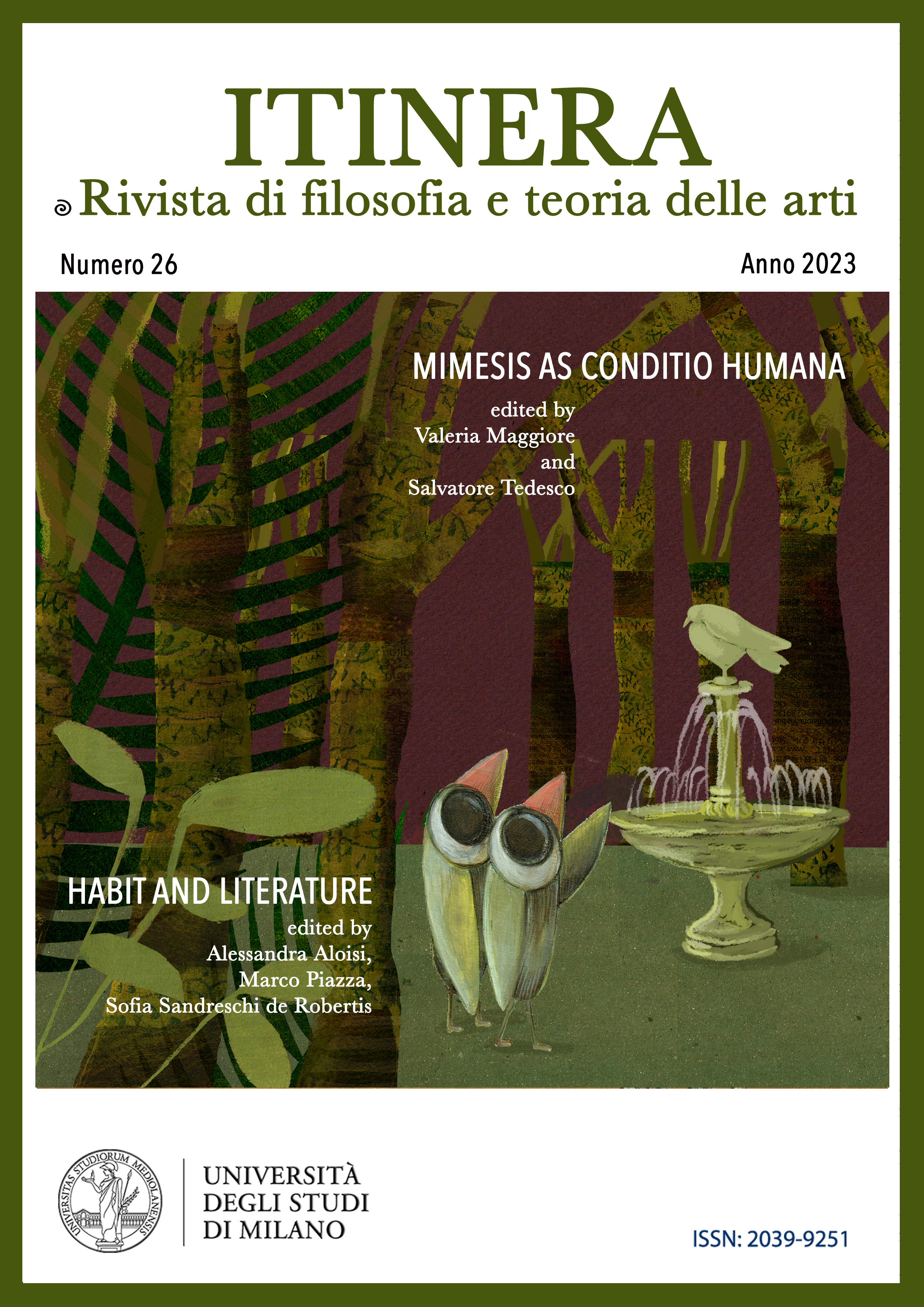Stadi sul cammino della mimesis: Kierkegaard e la dialettica tra introflessione ed estroflessione
DOI:
https://doi.org/10.54103/2039-9251/22236Parole chiave:
Kierkegaard; Mimesis; Aesthetics; Religion; Introflection; AlienationAbstract
The aim of this paper is to explore some existential possibilities that the concept of mimesis has in Kierkegaard. To this end, mimesis will be analyzed in two moments of his: in the life of the aesthete in Either-Or, where mimesis is related to the notions of poetry and fantasy, and in relation to the figures of the lily in the field and the bird in the sky. Two different notions of mimesis will then be studied in their dialectic between introspection and alienation. The aesthetic stage of mimesis will reveal the paradox of aesthetic life: on the one hand, the aesthete is apparently introflected, living in a world constructed of mimetic phantasms in his own image, but on the other hand, trapped in these reflections, he is unable to grasp his own self as a real possibility and is thus hopelessly alienated from himself. The opposite happens in the religious stage of mimesis, in which it is revealed that only in the apparent extroversion of imitating the absolute other is it possible to grasp one’s own self.
Riferimenti bibliografici
Cockayne, J., Imitation and Contemporaneity: Kierkegaard and the Imitation of Christ, in “Heythrop Journal”, LXIII (4), 2022
Compaijen, R., Authenticity and Imitation: On the Role of Moral Exemplarity in Anti-Climacus’ Ethics, in “Kierkegaard Studies Yearbook”, XVI, 2011
D’Angelo, P., Estetismo, il Mulino, Bologna 2004
Di Santo, F., Genealogia della mimesis. Fra mimesis antica e imitatio rinascimentale, ETS, Pisa 2016.
Garff, J., A Matter of Mimesis: Kierkegaard and Ricoeur on Narrative Identity, in “Kierkegaard Studies Yearbook”, XX, 2015
Halliwell, S., L’estetica della mimesis. Testi antichi e problemi moderni (2002), trad. it. di D. Guastini e L. Maimone Ansaldo Patti, a cura di G. Lombardo, Aesthetica Palermo 2009
Heidegger, M., L’epoca dell’immagine del mondo (1938), trad. it. di V. Cicero, in Holzwege. Sentieri erranti nella selva, Bompiani, Milano 2019
Jacobi, F. H., Lettera a Fichte (1799-1816), trad. it. di A. Acerbi, Napoli, La Scuola di Pitagora 2007
Kaftanski, W., Mimesis in Kierkegaard’s ‘Does a Human Being have the Right to Let Himself Put to Death for the Truth?’ Remarks on the Formation of the Self, in “Kierkegaard Studies Yearbook”, XVI, 2011
Id., Kierkegaard on Imitation and Ethics: Toward a Secular Project?, in “Journal of Religious Ethics”, XLVIII/3
Id., Kierkegaard, Mimesis, and Modernity. A Study of Imitation, Existence, and Affect, Routledge, London 2022
Id., Kierkegaard’s Aesthetics and the Aesthetic of Imitation, in “Kierkegaard Studies Yearbook”, XIX, 2014
Id., The Socratic Dimension of Kierkegaard’s Imitation, in “The Heythrop Journal”, LVIII, 2017
Kierkegaard, S., Enten-Eller (1843), trad. it. di A. Cortese, Adelphi, Milano 1976-1989
Id., Il giglio nel campo e l’uccello nel cielo (1849), trad. it. di E. Rocca, Donzelli, Roma 2011
Id., La malattia per la morte (1849), trad. it. di E. Rocca, Donzelli, Roma 2011
Id., La ripresa. Tentativo di psicologia sperimentale di Costantin Constantius (1843), trad. it. di A. Zucconi, SE, Milano 2013
Id., Sulla mia attività di scrittore (1851), trad. it. di A. Scaramuccia, ETS, Pisa 2006
Id., Timore e tremore (1843), trad. it. di C. Fabro, BUR, Milano 2010
Matassi, E., La figura impossibile: Kierkegaard, Mozart e “l’assolutamente musicale”, in “NotaBene. Quaderni di studi kierkegaardiani», VII, 2009
Monier-Williams, M., Leumann, E., Cappeller, C.J.W., A Sanskrit-English Dictionary. Etymologically and Philologically Arranged with Special References to Cognate Indo-European Languages, Oxford University Press, Oxford 1899
Pokorny, J., Indogermanisches Etymologisches Wörterbuch, Francke, Bern 1959
Ramazzotto, N., Kierkegaard, Hegel e il segreto vuoto di Don Giovanni, in «NotaBene. Quaderni di studi kierkegaardiani», X, 2018
Id., Riflessione, datità, alterità. Note su Jacobi e Kierkegaard critici dell’idealismo, in «Archivio di Filosofia», LXXXVIII, (2/3) 2020
Rocca, E., If Abraham is not a Human Being, in “Kierkegaard Studies Yearbook”, VII 2002
Id., L’esempio etico tra ammirazione e sequela: Quattro figure kierkegaardiane, in “Rivista di storia della filosofia”, XXXIV (1), 2023
Id., Kierkegaard, Carocci, Roma 2012
Id., Kierkegaard’s second aesthetics, in “Kierkegaard Studies Yearbook”, IV, 1999
Id., Tra estetica e teologia. Studi kierkegaardiani, ETS, Pisa 2004
Stan, L., Imitation, in J. Stewart, S.M. Emmanuel and W. McDonald (ed. by), Kierkegaard’s Concepts, Vol. 15, Tome III, Routledge, London 2021
Stewart, J., Kierkegaard as a Thinker of Alienation, in “Kierkegaard Studies Yearbook”, XXIV 2019
Id., Søren Kierkegaard: Subjectivity, Irony, & the Crisis of Modernity, Oxford University Press, Oxford 2015
Dowloads
Pubblicato
Fascicolo
Sezione
Licenza
Copyright (c) 2024 Ramazzotto

Questo lavoro è fornito con la licenza Creative Commons Attribuzione - Condividi allo stesso modo 4.0.
Gli autori che pubblicano su questa rivista accettano le seguenti condizioni:
1. Gli autori mantengono i diritti sulla loro opera e cedono alla rivista il diritto di prima pubblicazione dell'opera, contemporaneamente licenziata sotto una Licenza Creative Commons - Attribuzione - Condividi allo stesso modo 4.0 internazionale che permette ad altri di condividere l'opera indicando la paternità intellettuale e la prima pubblicazione su questa rivista.
2. Gli autori possono aderire ad altri accordi di licenza non esclusiva per la distribuzione della versione dell'opera pubblicata (es. depositarla in un archivio istituzionale o pubblicarla in una monografia), a patto di indicare che la prima pubblicazione è avvenuta su questa rivista.
3. Gli autori possono diffondere la loro opera online (es. in repository istituzionali o nel loro sito web) prima e durante il processo di submission, poiché può portare a scambi produttivi e aumentare le citazioni dell'opera pubblicata (Vedi The Effect of Open Access).





